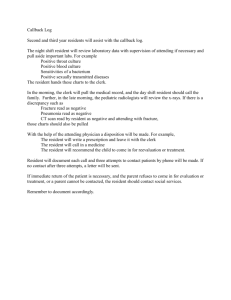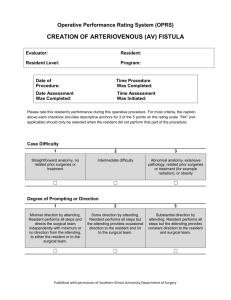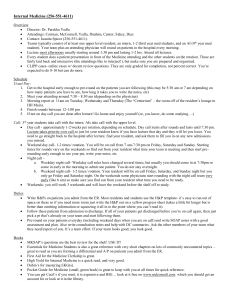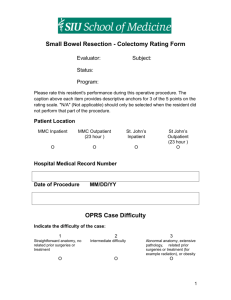p-value
advertisement
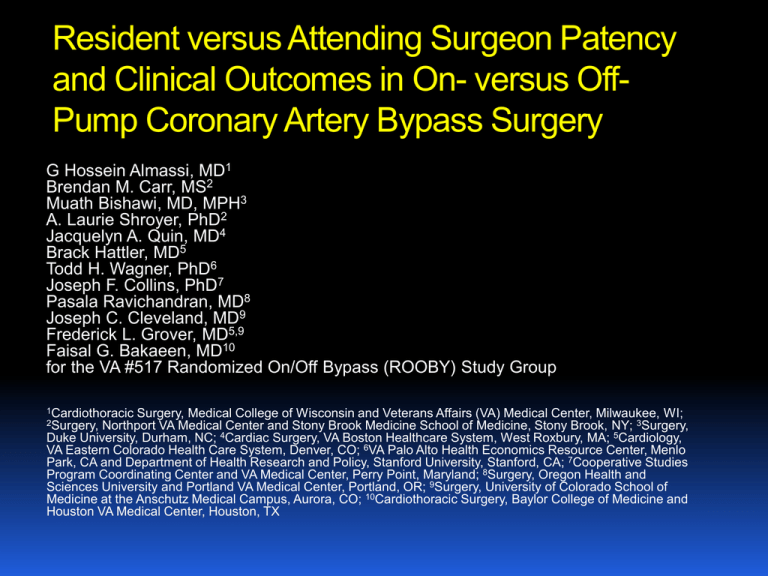
Resident versus Attending Surgeon Patency and Clinical Outcomes in On- versus OffPump Coronary Artery Bypass Surgery G Hossein Almassi, MD1 Brendan M. Carr, MS2 Muath Bishawi, MD, MPH3 A. Laurie Shroyer, PhD2 Jacquelyn A. Quin, MD4 Brack Hattler, MD5 Todd H. Wagner, PhD6 Joseph F. Collins, PhD7 Pasala Ravichandran, MD8 Joseph C. Cleveland, MD9 Frederick L. Grover, MD5,9 Faisal G. Bakaeen, MD10 for the VA #517 Randomized On/Off Bypass (ROOBY) Study Group 1Cardiothoracic Surgery, Medical College of Wisconsin and Veterans Affairs (VA) Medical Center, Milwaukee, WI; 2Surgery, Northport VA Medical Center and Stony Brook Medicine School of Medicine, Stony Brook, NY; 3Surgery, Duke University, Durham, NC; 4Cardiac Surgery, VA Boston Healthcare System, West Roxbury, MA; 5Cardiology, VA Eastern Colorado Health Care System, Denver, CO; 6VA Palo Alto Health Economics Resource Center, Menlo Park, CA and Department of Health Research and Policy, Stanford University, Stanford, CA; 7Cooperative Studies Program Coordinating Center and VA Medical Center, Perry Point, Maryland; 8Surgery, Oregon Health and Sciences University and Portland VA Medical Center, Portland, OR; 9Surgery, University of Colorado School of Medicine at the Anschutz Medical Campus, Aurora, CO; 10Cardiothoracic Surgery, Baylor College of Medicine and Houston VA Medical Center, Houston, TX Presenter Disclosure No disclosure to report Funding Cooperative Studies Program of the Department of Veterans Affairs Office of Research and Development and the Department of Veterans Affairs Central Office, Office of Patient Care Services. Offices of Research and Development at the Zablocki VA Medical Center, Northport VA Medical Center, and the VA Eastern Colorado Healthcare System. Background Residents must be trained to perform cardiac surgical procedures Balance between education and what is best for the patient Prior studies have shown no impact on CABG clinical outcomes Little information about effect on graft patency Background Bakaeen et al., 2012 – residents and attendings had similar outcomes and 1-year patency Bakaeen et al., 2009 – residents had longer operative times, perfusion and cross-clamp times, but similar outcomes Guo et al., 2008 – residents /fellows vs. consultants had similar operative morbidity and mortality in onpump CABG Background Haan et al., 2007 – hospitals with residency programs have longer perfusion times but similar outcomes Asimakopoulos et al., 2006 – residents had similar operative morbidity and mortality in off-pump CABG Ascione et al., 2004 – residents had similar morbidity and mortality in high-risk off-pump CABG patients Research Questions Do different clinical outcomes result when residents vs. attendings perform the majority of distal coronary anastomoses? Do grafts performed during CABG by residents vs. attendings have different rates of patency at 1 year postop? Are these results different for on-pump vs. off-pump CABG? ROOBY Trial VA Cooperative Study (18 centers) February 2002 – May 2008 Prospective, randomized, single-blinded Comparison of CABG with and without CPB ONCAB (n = 1,099) OPCAB (n = 1,104) Total (n = 2,203) Study Population All patients = 1,272 16 centers with cardiac surgery residents Data on resident anastomoses captured beginning July 2003 OPCAB = 639 Patients Resident as primary surgeon: 431 (67.4%) ONCAB = 633 Patients Resident as primary surgeon: 493 (77.9%) Definition Primary surgeon: The individual (resident or attending) who performed ≥ 50% of the distal anastomoses in a given patient Clinical Outcomes Short-term (30-day) composite endpoint: Death Reoperation New mechanical support Cardiac arrest Coma Stroke Renal failure requiring dialysis 1-year composite endpoint: Death from any cause within 1 year after surgery Nonfatal myocardial infarction between 30 days and 1 year Any revascularization procedure between 30 days and 1 year Graft Patency Coronary angiography at 1 year postop FitzGibbon classification A = An excellent/unimpaired graft B = An impaired graft with a stenosis >50% reducing the caliber of the graft to <50% of the target artery diameter O = A completely occluded graft Statistical Methods Discrete variables: Chi-square or Fisher Exact tests Continuous variables: Student T-tests Multivariate Regression Significance at p < 0.01 for all ROOBY sub-studies Results Baseline patient characteristics Patient risk profile On-pump N=633 Off-pump N=639 Resident n/N (%) Attending n/N (%) p-value Resident n/N (%) Attending n/N (%) p-value 119/493 (24.1) 20/140 (14.3) 0.013 89/431 (20.6) 44/208 (21.2) 0.88 Creatinine > 1.5 mg/dl 30/493 (6.1) 14/140 (10.0) 0.11 38/431 (8.8) 17/208 (8.2) 0.79 Cerebrovascular accident 31/493 (6.3) 13/140 (9.3) 0.22 26/431 (6.0) 14/208 (6.7) 0.73 Peripheral artery disease 61/493 (12.4) 18/140 (12.9) 0.88 65/431 (15.1) 40/208 (19.2) 0.18 Diabetes 233/493 (47.3) 63/140 (45.0) 0.64 202/431 (46.9) 82/208 (39.4) 0.08 Hypertension 424/493 (86.0) 128/140 (91.4) 0.09 374/431 (86.8) 180/208 (86.5) 0.93 10/493 (2.0) 2/140 (1.4) 0.65 14/429 (3.3) 11/208 (5.3) 0.22 COPD Atrial fibrillation LVEF by category < 35% ≥ 35% 0.64 23/485 (4.7) 462/485 (95.3) 5/132 (3.8) 127/132 (96.2) Prior MI 142/490 (29.0) 39/138 (28.3) β-Blocker Use 302/493 (61.3) Aspirin Urgent case 0.05 19/419 (4.5) 400/419 (95.5) 17/201 (8.5) 184/201 (91.5) 0.87 116/427 (27.2) 63/208 (30.3) 0.41 83/140 (59.3) 0.67 275/431 (63.8) 127/208 (61.1) 0.50 411/493 (83.4) 119/140 (85.0) 0.64 370/431 (85.8) 168/208 (80.8) 0.10 60/493 (12.2) 16/140 (11.4) 0.81 62/431 (14.4) 27/208 (13.0) 0.63 Coronary territories and anastomoses per primary surgeon On-pump N=633 Coronary anatomy Territories with disease 1 2 3 Off-pump N=639 Resident n/N (%) Attending n/N (%) p-value Resident n/N (%) Attending n/N (%) p-value 34/493 (6.9) 133/493 (27.0) 322/493 (65.3) 9/140 (6.4) 31/140 (22.1) 100/140 (71.4) 0.43 34/431 (7.9) 132/431 (30.6) 263/431 (61.0) 11/207 (5.3) 61/207 (29.5) 132/207 (63.8) 0.35 Distals performed by Resident only Attending only Both 303/633 (47.9) 121/633 (19.1) 209/633 (33.0) *NOTE: p-value is for the comparison between treatment groups 269/639 (42.1) 168/639 (26.3) 202/639 (31.6) 0.008* Comparison of target vessels quality based on who actually performed the anastomoses On-pump n/N (%) OR mean ± SD Resident Attending Off-pump n/N (%) OR mean ± SD p-value Resident Attending p-value 414/443 (93.5) 29/443 (6.5) 159/179 (88.8) 20/179 (11.2) 0.05 62/69 (89.9) 7/69 (10.1) 0.75 196/211 (92.9) 15/211 (7.1) 0.51 28/30 (93.3) 2/30 (6.7) 0.38 46/52 (88.5) 6/52 (11.5) 0.21 130/142 (91.5) 12/142 (8.5) 0.48 LAD anastomoses Quality of target Good/Moderate Poor 450/482 (93.4) 32/482 (6.6) Quality of target Good/Moderate Poor 164/176 (93.2) 12/176 (6.8) Quality of target Good/Moderate Poor 304/331 (91.8) 27/331 (8.2) Quality of target Good/Moderate Poor 40/45 (88.9) 5/45 (11.1) Quality of target Good/Moderate Poor 43/47 (91.5) 4/47 (8.5) Quality of target Good/Moderate Poor 134/156 (85.9) 22/156 (14.1) Quality of target Good/Moderate Poor 21/23 (91.3) 2/23 (8.7) 118/136 (86.8) 0.01 18/136 (13.2) Diagonal anastomoses 48/51 (94.1) 0.81 114/129 (88.4) 3/51 (5.9) 15/129 (11.6) Circumflex (AV) / OM anastomoses 130/145 (89.7) 0.44 15/145 (10.3) Ramus anastomoses 207/227 (91.2) 20/227 (8.8) 15/18 (83.3) 0.55 40/41 (97.6) 3/18 (16.7) 1/41 (2.4) Right main coronary anastomoses 36/40 (90.0) 0.81 4/40 (10.0) PDA anastomoses 56/59 (94.9) 3/59 (5.1) 126/151 (83.4) 0.55 113/127 (89.0) 25/151 (16.6) 14/127 (11.0) Posterolateral anastomoses 0.22 14/18 (77.8) 14/14 (100.0) 4/18 (22.2) 0/14 (0.0) 0.37 17/18 (94.4) 1/18 (5.6) Operative variables by primary surgeon Patients operative profile On-pump N=633 Off-pump N=639 Resident n/N (%) Attending n/N (%) p-value Resident n/N (%) Attending n/N (%) p-value Units of packed RBC 1.0 ± 1.6 (n=493) 0.9 ± 1.6 (n=140) 0.89 1.0 ± 1.5 (n=430) 1.0 ± 1.6 (n=208) 0.65 Units of fresh frozen plasma 0.4 ± 1.1 (n=493) 0.5 ± 1.4 (n=140) 0.51 0.5 ± 1.3 (n=430) 0.5 ± 1.3 (n=208) 0.73 0.3 ± 1.5 (n=493) 14/493 (2.8) 0.1 ± 0.6 (n=140) 6/140 (4.3) 0.03 0.4 ± 1.7 (n=430) 17/431 (3.9) 0.4 ± 1.5 (n=208) 5/208 (2.4) 0.96 Units of platelets Take down and redo of distal 0.39 0.32 Short-term Clinical Outcomes On-pump n/N (%) OR mean ± SD Resident Attending Short-term composite* 24/493 (4.9) 10/140 (7.1) Reoperation for bleeding 9/493 (1.8) Stroke Renal failure requiring dialysis Prolonged vent >48hrs Resident Attending p-value 0.29 27/431 (6.3) 10/208 (4.8) 0.46 4/140 (2.9) 0.45 14/431 (3.2) 4/208 (1.9) 0.34 3/493 (0.6) 2/140 (1.4) 0.33 3/431 (0.7) 2/208 (1.0) 0.72 2/493 (0.4) 0/140 (0.0) 0.45 3/431 (0.7) 2/208 (1.0) 0.72 15/493 (3.0) 6/140 (4.3) 0.47 21/431 (4.9) 9/208 (4.3) 0.76 Re-intubation 13/493 (2.6) 5/140 (3.6) 0.56 16/429 (3.7) 5/208 (2.4) 0.38 MI 18/493 (3.7) 4/140 (2.9) 0.65 25/431 (5.8) 12/208 (5.8) 0.99 New mechanical sup. 5/493 (1.0) 1/140 (0.7) 0.75 5/431 (1.2) 4/208 (1.9) 0.44 Mediastinitis 4/493 (0.8) 4/140 (2.9) 0.06 3/431 (0.7) 5/208 (2.4) 0.07 Operative Death 3/493 (0.6) 2/140 (1.4) 0.33 5/431 (1.2) 1/208 (0.5) 0.40 7.6 ± 5.3 (n=486) 8.1 ± 6.8 (n=139) 0.43 7.6 ± 4.4 (n=425) 7.9 ± 5.6 (n=203) 0.53 Hospital length of stay (days) p-value Off-pump n/N (%) OR mean ± SD * Short-term composite endpoint included death, reoperation, new mechanical support, cardiac arrest, coma, stroke, or renal failure requiring dialysis before discharge or within 30 days after surgery 1-Year Clinical Outcomes On-pump n/N (%) OR mean ± SD (n) Off-pump n/N (%) OR mean ± SD (n) Resident Attending p-value Resident Attending p-value 1-year composite* 32/493 (6.5) 8/140 (5.7) 0.74 44/431 (10.2) 19/208 (9.1) 0.67 All-cause death 12/493 (2.4) 4/140 (2.9) 0.78 17/431 (3.9) 5/208 (2.4) 0.32 Repeat revascularization† 16/493 (3.2) 4/140 (2.9) 0.82 25/431 (5.8) 11/208 (5.3) 0.79 Non-fatal MI† 8/493 (1.6) 2/140 (1.4) 0.87 5/431 (1.2) 4/208 (1.9) 0.44 *1-year composite endpoint included death from any cause within 1 year after surgery, nonfatal myocardial infarction between 30 days and 1 year, and any revascularization procedure between 30 days and 1 year † These two late adverse outcomes were evaluated from the time of 30-days post-surgery up until 1-year follow-up 1-Year FitzGibbon Patency On-pump Resident n/N (%) Overall A B O SVG A B O LIMA A B O Attending n/N (%) Off-pump p-value Resident n/N (%) Attending n/N (%) 0.72 590/711 (83.0) 262/318 (82.4) 23/711 (3.2) 8/318 (2.5) 98/711 (13.8) 48/318 (15.1) 0.94 491/636 (77.2) 328/428 (76.6) 27/636 (4.2) 20/428 (4.7) 118/636 (18.6) 80/428 (18.7) 0.81 314/414 (75.8) 178/228 (78.1) 15/414 (3.6) 8/228 (3.5) 85/414 (20.5) 42/228 (18.4) 0.51 260/369 (70.5) 213/294 (72.4) 12/369 (3.3) 13/294 (4.4) 97/369 (26.3) 68/294 (23.1) 0.42 253/268 (94.4) 6/268 (2.2) 9/268 (3.4) 71/74 (95.9) 0/74 (0.0) 3/74 (4.1) p-value 0.78 219/247 (88.7) 14/247 (5.7) 14/247 (5.7) 99/112 (88.4) 5/112 (4.5) 8/112 (7.1) A = An excellent/unimpaired graft B = An impaired graft with a stenosis >50% reducing the caliber of the graft to <50% of the target artery diameter O = A completely occluded graft SVG = Saphenous vein graft LIMA = Left internal mammary artery Limitations Attendings could have assisted residents in ways not documented Predominantly male veteran population Subgroup analysis Resident anastomosis data not captured during first year of ROOBY trial Follow-up limited to 1 year Conclusions For ROOBY Trial patients: No difference in perioperative outcomes No difference in 1-year outcomes No difference in 1-year graft patency Conclusion Residents can and should be trained in advanced surgical techniques with no negative impact on surgical outcomes. Thank You

